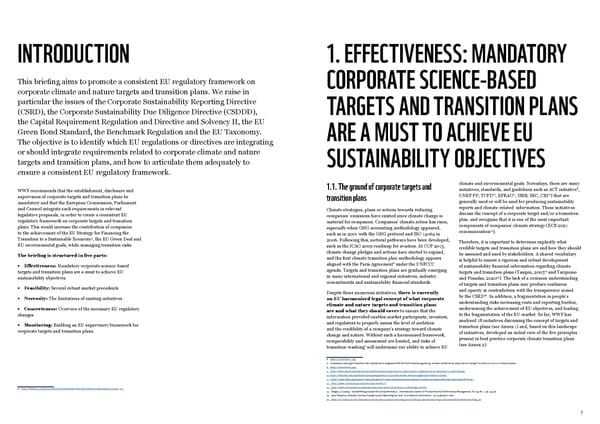7 1. EFFECTIVENESS: MANDATORY CORPORATE SCIENCE-BASED TARGETS AND TRANSITION PLANS ARE A MUST TO ACHIEVE EU SUSTAINABILITY OBJECTIVES 6 https://actinitiative.org/ 7 Companies claiming to transition their operations in alignment with EU environmental goals (e.g. net zero emissions by 2050) but not doing it in practice or not in a timely manner . 8 https://actinitiative.org/. 9 https://www.unepfi.org/publications/banking-publications/practical-approaches-to-applying-the-eu-taxonomy-to-bank-lending/ 10 https://www.fsb-tcfd.org/webinar-proposed-guidance-on-climate-related-metrics-targets-and-transition-plans/ 11 https://www.efrag.org/Assets/Download?assetUrl=/sites/webpublishing/SiteAssets/Cover%20note%20for%20Batch%201%20WPs.pdf 12 https://www.climatebonds.net/principles-transition 13 https://www.ecb.europa.eu/press/key/date/2021/html/ecb.sp211020~03fba70983.en.html 14 Tangen, S. (2005), “Demystifying productivity and performance”, International Journal of Productivity and Performance Management, Vol. 54 No. 1, pp. 34-46. 15 Lara Tarquinio, Stefanía Carolina Posadas (2020) Exploring the term “non-financial information”: an academics’ view. 16 https://ec.europa.eu/info/business-economy-euro/company-reporting-and-auditing/company-reporting/corporate-sustainability-reporting_en 1.1. The ground of corporate targets and transition plans Climate strategies, plans or actions towards reducing companies’ emissions have existed since climate change is material for companies. Companies’ climate action has risen, especially when GHG accounting methodology appeared, such as in 2001 with the GHG protocol and ISO 14064 in 2006. Following this, sectoral pathways have been developed, such as the ICAO 2009 roadmap for aviation. At COP 2015, climate change pledges and actions have started to expand, and the first climate transition plan methodology appears aligned with the Paris Agreement 6 under the UNFCCC agenda. Targets and transition plans are gradually emerging in many international and regional initiatives, industry commitments and sustainability financial standards. Despite these numerous initiatives, there is currently no EU harmonised legal concept of what corporate climate and nature targets and transition plans are and what they should cover to ensure that the information provided enables market participants, investors, and regulators to properly assess the level of ambition and the credibility of a company’s strategy toward climate change and nature. Without such a harmonised framework, comparability and assessment are limited, and risks of transition-washing 7 will undermine our ability to achieve EU climate and environmental goals. Nowadays, there are many initiatives, standards, and guidelines such as ACT initiative 8 , UNEP FI 9 , TCFD 10 , EFRAG 11 , ISSB, SEC, CBI 12 ) that are generally used or will be used for producing sustainability reports and climate-related information. These initiatives discuss the concept of a corporate target and/or a transition plan, and recognise that it is one of the most important components of companies’ climate strategy (ECB 2021 communication 13 ). Therefore, it is important to determine explicitly what credible targets and transition plans are and how they should be assessed and used by stakeholders. A shared vocabulary is helpful to ensure a rigorous and robust development of sustainability financial information regarding climate targets and transition plans (Tangen, 2005 14 and Tarquinio and Posadas, 2020 15 ). The lack of a common understanding of targets and transition plans may produce confusion and opacity in contradiction with the transparency aimed by the CSRD 16 . In addition, a fragmentation in people’s understanding risks increasing costs and reporting burden, undermining the achievement of EU objectives, and leading to the fragmentation of the EU market. So far, WWF has analysed 18 initiatives discussing the concept of targets and transition plans (see Annex 1) and, based on this landscape of initiatives, developed an initial view of the five principles present in best practice corporate climate transition plans (see Annex 2). INTRODUCTION This briefing aims to promote a consistent EU regulatory framework on corporate climate and nature targets and transition plans. We raise in particular the issues of the Corporate Sustainability Reporting Directive (CSRD), the Corporate Sustainability Due Diligence Directive (CSDDD), the Capital Requirement Regulation and Directive and Solvency II, the EU Green Bond Standard, the Benchmark Regulation and the EU Taxonomy. The objective is to identify which EU regulations or directives are integrating or should integrate requirements related to corporate climate and nature targets and transition plans, and how to articulate them adequately to ensure a consistent EU regulatory framework. 5 https://finance.ec.europa.eu/publications/strategy-financing-transition-sustainable-economy_en. WWF recommends that the establishment, disclosure and supervision of corporate targets and transition plans be mandatory and that the European Commission, Parliament and Council integrate such requirements in relevant legislative proposals, in order to create a consistent EU regulatory framework on corporate targets and transition plans. This would increase the contribution of companies to the achievement of the EU Strategy for Financing the Transition to a Sustainable Economy 5 , the EU Green Deal and EU environmental goals, while managing transition risks. The briefing is structured in five parts: • Effectiveness: Mandatory corporate science-based targets and transition plans are a must to achieve EU sustainability objectives • Feasibility: Several robust market precedents • Necessity: The limitations of existing initiatives • Concreteness: Overview of the necessary EU regulatory changes • Monitoring: Building an EU supervisory framework for corporate targets and transition plans.
 Corporate Sustainability & Transition Plans Page 3 Page 5
Corporate Sustainability & Transition Plans Page 3 Page 5